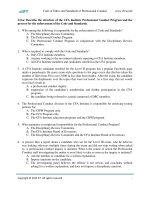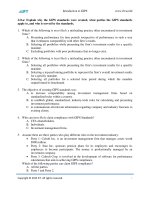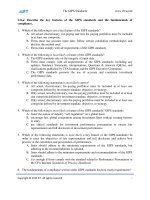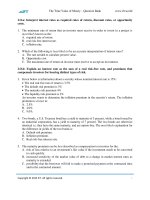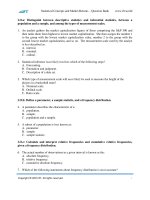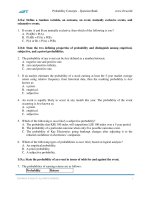CFA 2018 quest bank r39 working capital management q bank
Bạn đang xem bản rút gọn của tài liệu. Xem và tải ngay bản đầy đủ của tài liệu tại đây (422.73 KB, 12 trang )
Working Capital Management – Question Bank
www.ift.world
LO.a: Describe primary and secondary sources of liquidity and factors that influence a
company’s liquidity position.
1. Which action is least likely considered a secondary source of liquidity?
A. Filing for bankruptcy protection.
B. Increasing the efficiency of cash flow management.
C. Renegotiating current debt contracts to lower interest payments.
2. Which of the following is least likely a secondary source of liquidity?
A. Negotiating debt contracts.
B. Filing for bankruptcy protection and reorganization.
C. Cash flow management
3. Which of the following is least likely considered a primary source of liquidity?
A. Centralized cash management system.
B. Debt contract.
C. Trade credit.
4. Which of the following is most likely considered a ‘drag’ on liquidity?
A. Obsolete inventory.
B. Reduced credit limits.
C. Making early payments.
LO.b: Compare a company’s liquidity measures with those of peer companies.
The following information relates to Questions 5-7
Ahmed Rashid is evaluating companies in the agricultural pesticides industry and has compiled
the following information:
2012
2013
Credit Sales
Average
Credit Sales
Average
Company
Receivables
Receivables
Balance ($)
Balance ($)
Bayer Corp.
$6.0 million
2.0 million
7.0 million
2.2 million
Excel Corp.
$4.0 million
2.2 million
5.0 million
2.5 million
Insecticides.
$3.5 million
1.8 million
4.0 million
2.0 million
Phyto Corp.
$1.5 million
1.1 million
1.6 million
1.2 million
Industry
26.0 million
6.0 million
29.0 million
6.4 million
5. Which of the following companies had the highest numbest of days of receivables for the
year 2012?
A. Bayer Corp.
B. Insecticides.
C. Phyto Corp.
6. Which of the companies has the lowest accounts receivables turnover in the year 2013?
A. Insecticides.
Working Capital Management – Question Bank
www.ift.world
B. Excel Corp.
C. Phyto Corp.
7. The industry average receivables collection period:
A. Increased from 2012 to 2013.
B. Decreased from 2012 to 2013.
C. Did not change from 2012 to 2013.
LO.c: Evaluate working capital effectiveness of a company based on its operating and cash
conversion cycles, and compare the company’s effectiveness with that of peer companies.
8. The following information is available for a company and the industry in which it operates:
Company Industry
Accounts receivable turnover 4.7 times 5.4 times
Inventory turnover
3.3 times 3.2 times
Number of days of payables 21 days
29 days
Relative to the industry, the company’s operating cycle:
A. and cash conversion cycle are both longer.
B. is longer, but its cash conversion cycle is shorter.
C. is shorter, but its cash conversion cycle is longer.
9. The following information is available for a company:
In Millions (€)
Credit sales
20,000
Cost of goods sold
15,000
Accounts receivable 2,000
Inventory
1,800
Accounts payable
2,600
Purchases
15,300
The net operating cycle of this company is closest to:
A. 18.3 days.
B. 22.4 days.
C. 9.8 days.
10. Given the following financial statement data, calculate the operating cycle for Alpha
Corporation.
Account
In Millions($)
Credit sales
60,000
Cost of goods sold
48,000
Account receivable 6,000
Inventory
5,500
Account payable
4,000
The operating cycle for this company is closest to:
Working Capital Management – Question Bank
www.ift.world
A. 45.20 days.
B. 49.75 days.
C. 78.32 days.
11. Given the following financial statement data, calculate the net operating cycle for Beta
Electronics Ltd.
Account
In Millions($)
Credit sales
100,000
Cost of goods sold
75,000
Account receivable
7,500
Inventory – Ending balance 5,000
Days of payables
49.50
The net operating cycle for this company is closest to:
A. 2.2 days.
B. 25.0 days.
C. 51.7 days.
12. A company’s largest supplier has decided to tighten credit terms. Earlier the company could
make payments within 20 days of purchase. Now the company is being asked to pay within
10 days of purchase. The most likely effect of this change is a (an):
A. decrease in the company’s operating cycle.
B. increase in the company’s net operating cycle.
C. increase in the company’s operating cycle.
LO.d: Describe how different types of cash flows affect a company’s net daily cash position.
13. Paragon, a shoe manufacturer, wants to maintain an adequate net daily cash position. Which
of the following actions will the company least likely take?
A. Monitor access to borrowing facilitates.
B. Predict the business cycles and seasonal effects.
C. Forecast depreciation and accruals.
14. A company manages its treasury function to exactly maintain its minimum daily balance
requirement. The following events occurred for the company on the same day:
$ millions
Funds transfer to subsidiaries
100
Maturing investments
75
Issues a stock dividend
15
Debt repayments
50
Minimum daily cash balance
25
The Treasurer would most likely need to increase borrowing for the day by:
A. $50 million.
Working Capital Management – Question Bank
www.ift.world
B. $75 million.
C. $100 million.
LO.e: Calculate and interpret comparable yields on various securities, compare portfolio
returns against a standard benchmark, and evaluate a company’s short-term investment
policy guidelines.
15. For a 90-day U.S. Treasury bill selling at a discount, which of the following methods most
likely results in the highest yield?
A. Bond equivalent yield.
B. Discount-basis yield.
C. Money market yield.
16. For a 90-day U.S. Treasury bill selling at a discount, which of the following most likely
results in the lowest yield?
A. Bond equivalent yield.
B. Discount-basis yield.
C. Money market yield.
17. A 30-day $1,000 U.S. Treasury bill sells for $984.10. The discount-basis yield (%) is closest
to:
A. 12.57%.
B. 16.45%.
C. 19.08%.
18. The bond equivalent yield for a 180-day U.S. Treasury Bill that has a price of 9,875 per
$10,000 face value is closest to:
A. 2.57%.
B. 2.77%.
C. 2.34%.
19. For a 91-day $100,000 T-bill which is being sold at a discounted rate of 6.79%, the money
market yield is closest to:
A. 6.79%.
B. 6.88%.
C. 6.91%.
20. The Money market yield for a 182-days U.S treasury bill that has a price $8,500 per $10,000
face value is closest to:
A. 34.91%.
B. 35.55%.
C. 45.50%.
21. A 270-day $1,000,000 security is currently selling for $987,025. The discount basis yield of
the security is closest to:
A. 1.73%.
Working Capital Management – Question Bank
www.ift.world
B. 1.75%.
C. 1.77%.
LO.f: Evaluate a company’s management of accounts receivable, inventory, and accounts
payable over time and compared to peer companies.
22. Assume a 365-day year and the following information for a company:
Current year
Previous year
Sales
$18,000
$20,000
Cost of goods sold
$9,000
$9,500
Inventory
$1,500
$1,600
Accounts payable
$700
$700
The firm’s days in payables for the current year is closest to:
A. 28.08.
B. 28.71.
C. 29.21.
23. A company uses trade credit terms of 3/10 net 40. If the account is paid on the 30th day, the
cost of trade credit is closest to:
A. 27.9.
B. 44.6.
C. 74.3.
24. Elixir Ltd. has a current ratio of 5 times and quick ratio of 3 times. If the company’s current
liabilities are $50 million, the amount of inventories is closest to:
A. $100 million.
B. $200 million.
C. $150 million.
25. Galaxy Chemicals Ltd. is increasing its credit terms for customers from 1/12, net 20 to 1/12,
net 50. The company will most likely experience:
A. an increase in cash on hand.
B. an increase in the average collection period.
C. a higher level of uncollectible accounts.
26. Suppose Casio Electronics uses trade credit with terms of 1/10, net 60. If the company pays
its account on the 60th day, the effective borrowing cost of skipping the discount on day 10 is
closest to:
A. 15.5%.
B. 7.61%.
C. 21.3%.
27. A company uses trade credit terms of 1/10 net 30. If the account is paid on the 30th day, the
effective borrowing cost of failing to take the discount is closest to:
A. 22%.
B. 20%.
Working Capital Management – Question Bank
www.ift.world
C. 24%.
LO.g: Evaluate the choices of short-term funding available to a company and recommend a
financing method.
28. Which of the following is most likely the best offer for borrowing $1,000,000 for one month?
A. Drawing down on a line of credit at 6% with a ½ % commitment fee on the full
amount with no compensating balances.
B. A banker’s acceptance at 6.25%, an all-inclusive rate.
C. Commercial paper at 5.65% with a dealer’s commission of 1/4% and a backup line
cost of 1/3%, both of which would be assessed on the $1 million of commercial paper
issued.
29. The cost of borrowing $3,000,000 for one month through a banker’s acceptance at a rate of
6.5%, an all-inclusive rate is closest to:
A. 5.65%.
B. 6.34%.
C. 6.54%.
30. The effective annualized cost (%) of a banker’s acceptance that has an all-inclusive annual
rate of 10.5% for a one-month loan of $4,000,000 is closest to:
A. 10.59.
B. 10.76.
C. 11.08.
31. A treasury manager in a company has to borrow $8,000,000 for a month to meet an
unforeseen short-term expense. Which of the following borrowing alternatives available to
him will have the lowest effective annual cost?
A. Line of credit at 6.8% with a 0.5% annual commitment fee.
B. A banker’s acceptance at 7.25%, an all-inclusive rate.
C. Commercial paper at 7% with an annual dealer’s commission of $2,500 and an annual
backup line cost of $4,200.
Working Capital Management – Question Bank
www.ift.world
Solutions
1. B is correct. Increasing the efficiency of cash flow management falls under primary sources
of liquidity.
2. C is correct. Cash flow management is a primary source of liquidity.
3. B is correct. Debt contract system is a secondary source of liquidity.
4. A is correct. Drags on liquidity include uncollected receivables, obsolete inventory and tight
credit.
5. C is correct.
Number of days of receivables =
Bayer Corp:
= 121.67 days
Excel Corp:
= 201 days
Insectisides:
= 188 days
Phyto Corp:
= 268 days
6. C is correct.
Receivables turnover =
Bayer Corp:
= 3.182
Excel Corp:
= 2.0
Insectisides:
= 2.0
Phyto Corp:
= 1.33
7. B is correct.
Industry average in 2012: 84.23 days
Industry average in 2013: 80.55 days
8. A is correct.
Company
Number of days receivables 365/4.7 = 78 days
Number of days inventory
365/3.3 = 111 days
Industry
365/5.4 = 68 days
365/3.2 = 114 days
Working Capital Management – Question Bank
www.ift.world
Operating cycles
78 + 111 = 189 Longer 68 + 114 = 182
Cash conversion cycle
189 - 21 = 168 Longer 182 - 29 = 153
Therefore, the operating cycle and cash conversion cycle are both longer for the company.
9. A is correct. Number of days of inventory =
Number of days of receivables =
= 43.80 days
= 36.50 days
Purchases = €15,300
Number of days of payables =
= 62.03 days
Net operating cycle is 43.80 + 36.50 – 62.03 = 18.27 days
10. C is correct.
Number of days of inventory =
Number of days of receivables =
= 41.82 days
= 36.50 days
Operating cycle = Average days in inventory + Average days in receivables
= 41.82 + 36.50 = 78.32 days
11. A is correct.
Number of days of inventory =
Number of days of receivables =
= 24.33 days
= 27.38 days
Number of days of payables = 49.50
Net operating cycle/ Cash conversion cycle = 24.33 + 27.38 - 49.50 = 2.21 days
12. B is correct. The operating cycle is equal to the number of days of inventory plus the number
of days of receivables. Hence the operating cycle is not impacted by a change in the number
of days of payables. The net operating cycle is equal to the operating cycle minus the number
of days of payables. If the number of days of payables decreases the net operating cycle will
increase.
13. C is correct. Accruals are paid at a later date, and depreciation is a noncash expense.
14. B is correct. The change in the net daily cash position (in millions) is calculated as below and
would require additional borrowing of $75 million:
Opening cash balance
$25
Fund transfer to subsidiaries
(100)
Maturing investments
75
Debt repayments
(50)
Change is cash for the day
(75)
75
Borrowing required
Closing cash balance
$25
Working Capital Management – Question Bank
www.ift.world
15. A is correct. Note that the face value is greater than the purchase price because the T-bill
sells at a discount:
(
)
(
)
(
BEY
)
𝐵𝐸𝑌>𝑀𝑀𝑌>𝐷𝐵𝑌
16. B is correct. Note that the face value is greater than the purchase price because the T-bill sells
at a discount:
(
(
)
(
)
)
(
)
(
)
𝐵𝐸𝑌>𝑀𝑀𝑌>𝐷𝐵𝑌
17. C is correct. The face value is greater than the purchase price because the T-bill sells at a
discount.
DBY = (
)
= 19.08%
18. A is correct.
(
=
= 2.57%
(
19. C is correct. Money- market yield =
Purchase price =
Therefore,
Money market yield = *
*
(
)
+
(
+ = $98,283.639
) = 6.91%
20. A is correct.
Money market yield = [($10,000 - $8,500)/$8,500] * (360/182) = 34.91%
21. A is correct.
)
)
Working Capital Management – Question Bank
[
][
[
www.ift.world
]
][
]
22. B is correct.
=
=
*
(
) (
[
)
+
]
= 28.71
23. C is correct. Cost of trade credit=
((
= ((
)
(
))
)
)
= 74.3%
24. A is correct.
Current ratio =
= Current assets/$50 = 5
Therefore, current assets = $250 million
Quick ratio = (Current assets –Inventory)/ Current Liabilities = 3
Quick ratio =
=3; therefore Inventory = $100 million
25. B is correct. A higher level of uncollectible accounts may occur, but a longer average
collection period will certainly occur.
26. B is correct. Cost = (1+ 0.01/0.99)(365/50) -1 = 7.61%
27. B is correct.
Cost of trade credit =
)
=((
=(
(
)
)
)
= 20.13%
28. C is correct. Evaluate the choices of short-term funding available to a company and
recommend a financing method.
Line of credit cost = [
] * 12
Line cost = ((
= 6.5%
)
(
))
Working Capital Management – Question Bank
Banker’s acceptance cost = (
) * 12
(
BA Cost =
)
(
)
= 6.28%
Commercial paper cost = [
CP Cost =
*(
] * 12
)
(
)
(
(
www.ift.world
)+
)
12 = 6.26%
29. C is correct.
BA cost =
(
= 6.535%
)
30. A is correct. Interest for the month =
= 35,000
Effective annualized cost = (
) * 12 =
31. C is correct. Line of credit cost = [
Interest = (
)
Commitment fee = (
= 0.1059 = 10.59%
] * 12
= 45,333.33
)
=3,333.33
Line of credit cost = *
+
Banker’s acceptance cost = (
= 7.30%
) * 12
Interest = (
)
= 48,333.33
Net proceeds = 8,000,000 – 48,333.33 = 7,951,666.67
Banker’s acceptance cost = (
)
= 7.29%
Commercial paper cost = [
Interest = (
)
Dealer’s commissions =
] * 12
= 46,666.67
=208.33
Backup costs =
= 350
Net proceeds = 8,000,000 – 46,666.67 = 7,953,333.33
Commercial paper cost = [
] * 12 = 7.13%
Working Capital Management – Question Bank
www.ift.world
Hence, commercial paper is the least expensive source of funding as it has the lowest
effective annual cost amongst the three alternatives.

